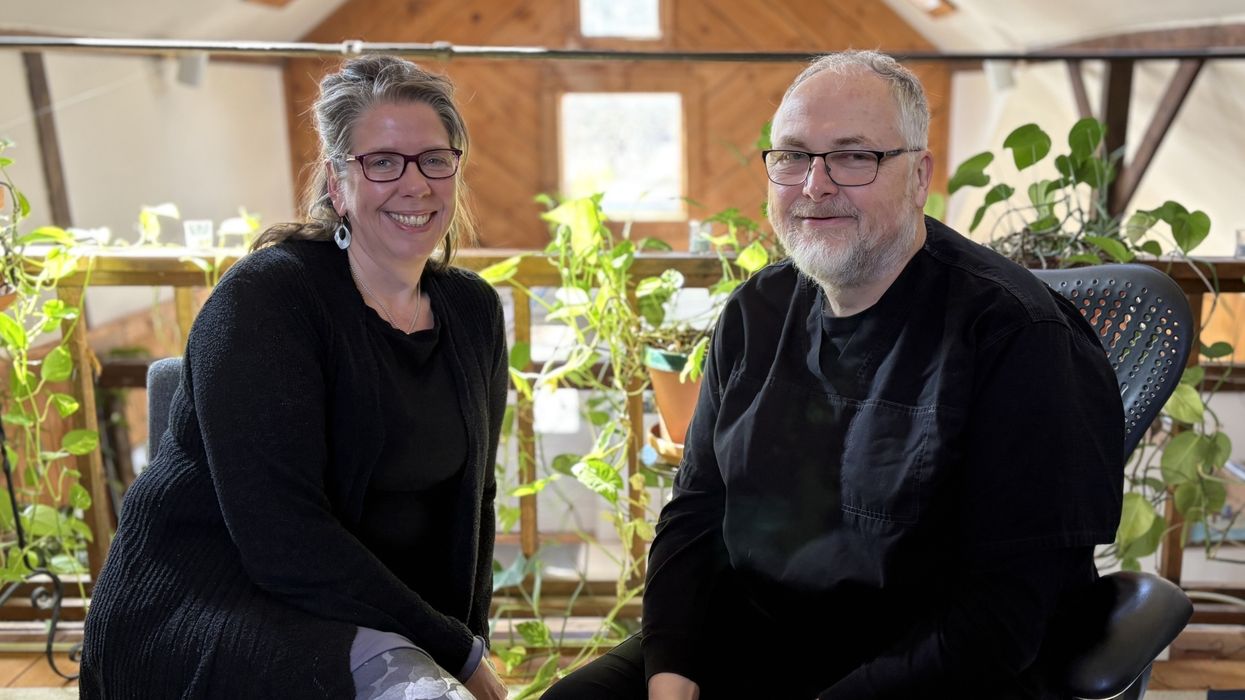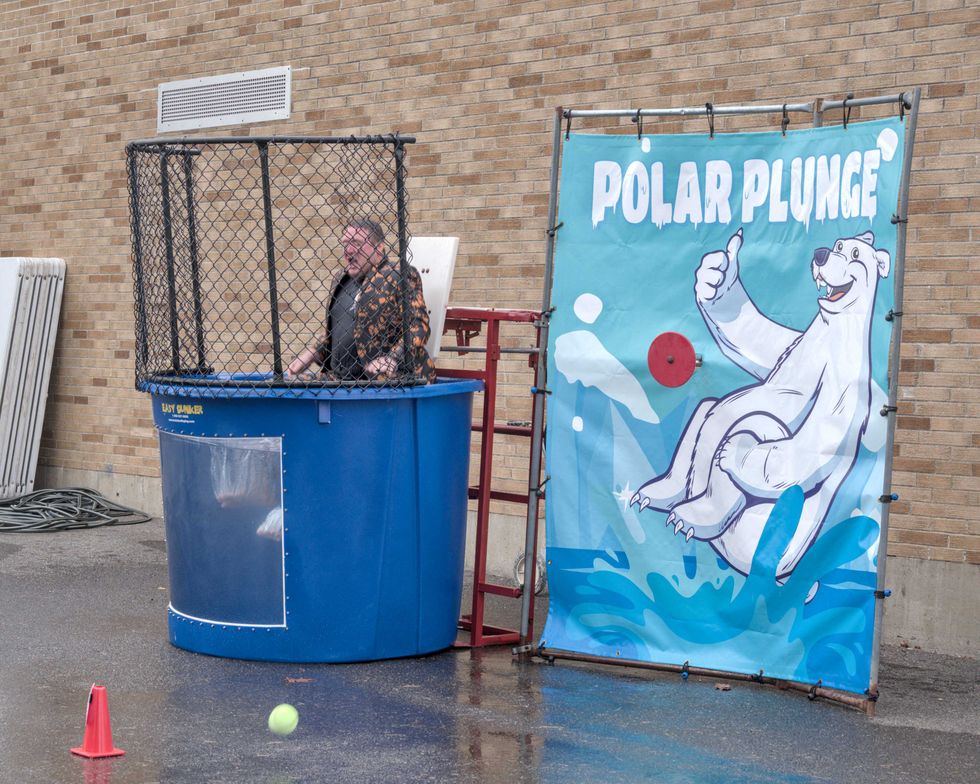Aimee Davis and Brian Crouse offer whole-person wellness in Millerton

Aimee Davis and Brian Crouse in their shared office space at 65 Main St. in Millerton.
Natalia Zukerman

Aimee Davis and Brian Crouse in their shared office space at 65 Main St. in Millerton.
‘We need to be touched, we need to be tended to, and we need to remember who we are and how we are actually doing,” said massage therapist Aimee Davis, her words echoing softly in the warmly lit loft of the space she shares with naturopathic doctor and acupuncturist Brian Crouse in Millerton. In a world that keeps us increasingly disconnected from our bodies, the healing practices of Davis and Crouse offer a sanctuary of care that integrates both physical and energetic restoration. They share a space and a mission of healing, one that embraces the complexity of the body, mind, and spirit.
Davis and Crouse both come from backgrounds rich with both experience and personal transformation. Their paths intersected in Millerton, where they now work alongside each other in a healing space that is as inviting and serene as their practices. At an early age, Davis was inspired by her parents’ work in science and medicine and at 18, she worked in a home for the mentally challenged, most of whom were chair-bound. “I realized then the obvious way that you can connect to another human even if they’re incapable of talking,” said Davis. A licensed massage therapist and intuitive healer, Davis has spent over two decades honing her craft in bodywork, energy healing, and coaching. Her work spans from deep tissue massage to Reiki, chakra balancing, and 4-dimensional healing. Yet, it’s the unique blending of these modalities that makes her approach so effective. “I prefer the mixed pot of whatever a person is, as opposed to just a sports massage or just an energy session,” said Davis, describing her belief in customizing healing practices to meet the distinct needs of every individual.
Brian Crouse’s path to healing also had its own meandering route. “When I was a kid, I just always had this thought I was going to be some kind of doctor/healer and also own a restaurant and also be a bass player,” Crouse recalls with a smile. He has managed to do all of that and more. After leaving chiropractic school, he owned a restaurant on Long Island for many years, but the call to medicine never left him. When he returned to his studies, he shifted focus a bit, eventually studying both naturopathic medicine and acupuncture. “I saw what food did to people over time,” he said, explaining the pivot that led him to a more holistic approach.
Today, Crouse blends his expertise in naturopathic medicine, acupuncture, and nutritional counseling to address the root causes of health issues. His practice is centered on supporting the body’s innate ability to heal. “As a naturopath, I use natural therapies rather than pharmaceutical drugs,” Crouse explained, emphasizing his belief in the body’s capacity for self-regulation. If there are any fears around acupuncture, Crouse assured, “It doesn’t hurt, and it’s a very relaxing and healing modality.”
Whether it’s Davis’s bodywork or Crouse’s naturopathic treatments that brings you into their office, both practitioners see patients as unique individuals, deserving tailored care. “It doesn’t have to be all one way or another,” said Crouse. “You don’t have to have a massage every two weeks, but you can combine things that work for you,” added Davis, emphasizing the importance of finding what resonates best for each person. For Crouse, it’s all about offering choices. “I try to guide people to the healing wisdom that’s inside them and reignite it,” he explained, ensuring that his patients are not just passive recipients of treatment, but active participants in their own healing journey.
While their professional lives are grounded in wellness, their personal passions also fuel their work. Brian, an avid musician, still finds time to play bass, even occasionally practicing in the shared office space. His passion for music is just one of the many ways he nurtures his own well-being and creativity, which he said, “helps me balance the demands of my practice.” Davis, too, finds time to engage in her own self-care and personal growth, and along with her bodywork practice, she also offers women’s circles and relationship coaching. “Everybody needs help,” she acknowledged, understanding that healing, both physical and emotional, is a lifelong journey.
“It’s not a luxury to take care of yourself,” said Davis. “It’s maintenance so you can live longer and feel better.”
“And as a society we’re losing touch with ourselves and our bodies, and this is a way to reconnect,” Crouse added. “Yea,” said Davis. “It’s stressful out there, and we need to come home to the body and each other.”
For more information or to book an appointment with Brian Crouse, call 518-592-1033 or visit www.drbriancrouse.com. For more information or to book an appointment with Aimee Davis, visit connectandbalance.amtamembers.com or call 860-248-5452
PINE PLAINS — The Pine Plains FFA Ag Fair brought a crowd to the high school on Church Street Saturday, Oct. 11.
Kicking off the day was the annual tractor pull, attracting a dedicated crowd that sat in bleachers and folding chairs for hours watching Allison-Chalmers, International Harvesters and John Deeres compete to pull the heaviest weights.
A large collection of food was on offer from the Pine Plains FFA and each one of the classes in the Pine Plains Central School District. The football team was selling pickles.
Stissing Mountain High School Principal Christopher Boyd enjoyed a dip in the dunk tank to raise money for the Pine Plains teachers’ union-sponsored scholarship.

The Rev. AJ Stack, center right, blessing a chicken at the pet blessing event at St. Thomas Episcopal Church in Amenia on Saturday, Oct. 4.
AMENIA — After serving more than five years as Priest-in-Charge of St. Thomas Episcopal Church in Amenia, the Rev. AJ Stack announced Tuesday, Oct. 7, that he will resign from the church and Food of Life/Comida de Vida pantry. His last day at his current post will be Sunday, Nov. 2, the conclusion of the Feast of All Saints.
The news was shared in two emails from Stack — one to Food of Life pantry subscribers and volunteers, and another to parish members.
“I write tonight with difficult news, and I wanted you to hear it from me as soon as the Vestry and I had a chance to meet,” he wrote. “After much prayer and careful discernment, I have submitted my resignation to the Vestry as Priest-in-Charge of St. Thomas, and therefore as Executive Director of Food of Life/Comida de Vida.”
Stack provided few details about his departure. At time of publication, he had not announced his next steps but said the decision was “not sudden,” and followed careful consideration over a period of months. He will not be leaving the area or the diocese.
An announcement about his path forward and the transition process is expected soon. In the meantime, Stack said he remains “fully present” at the church, and the food pantry services will continue without interruption.
Stack expressed gratitude for the community and the growth of St. Thomas’ mission during his tenure. “Together we have welcomed new neighbors and strengthened our outreach in meaningful ways,” he said. “I trust that good work will continue.”
He joined St. Thomas in March 2020 and guided the church and community through the challenges of the COVID-19 pandemic. In a recent interview with The News about the food pantry, Stack estimated that it serves 653 individuals from 156 households each week, highlighting a significant contribution to the community.
The announcement was met with messages of reassurance from pantry volunteers. Jolly Stewart, a Vestry member and volunteer, wrote to the community with words of reassurance following the announcement. “I have complete faith in the strength of the parish of St. Thomas,” she wrote. “Our history shows how we have done this time and again, each time becoming more than what we were before. We can, without a doubt, do this now.”
MILLERTON — Ten candidates for office in the Nov. 4 election will answer questions from Dutchess County voters at a candidate forum on Friday, Oct. 24, at the Annex at the NorthEast-Millerton Library located at 28 Century Blvd.
The forum, which is sponsored by the library, will be held from 6 to 7:30 p.m.
Candidates for local and county offices will answer questions from residents in attendance or from residents who have submitted questions in advance.
“We’re excited to keep the tradition of the candidate forum going,” said Rhiannon Leo-Jameson, director of the library. “Some years we can’t always get candidates together.”
This year’s forum will include:
Rachele Grieco Cole, a Democrat, and Chris Mayville, a Republican, who both are running uncontested for the North East Town Council;
Casey McCabe, a Democrat, also running uncontested for North East Justice.
Among Dutchess County races:
Tracy MacKenzie, who is endorsed by Republicans and Democrats, is running uncontested for Dutchess County Family Court Judge;
Kara Gerry, a Democrat, and Ned McLoughlin, a Republican, are in a contest for a Dutchess County Court judgeship currently held by McLoughlin.
Chris Drago, D-19, and Tonya Pulver, a Republican, are competing to represent Dutchess County’s19th District seat currently held by Drago.
Democratic incumbent Dan Aymar-Blair and Will Truitt, the Republican chair of the county legislature, are competing for the Dutchess County Comptroller position currently held by Aymar-Blair.
Leo-Jameson is encouraging questions for the candidates to be submitted in advance, which will not be revealed to candidates beforehand. Dutchess County residents may pose questions during the forum. To submit a question on the library’s website, go to the calendar at nemillertonlibrary.org and find the link in the Oct. 24calendar entries.
The format calls for opening statements from the candidates, followed by questions from residents, and candidates will be able to stay after the forum to answer questions personally.
The residence at 35 Amenia Union Road in Sharon was damaged after being struck by the Jeep Grand Cherokee around 3 p.m. on Saturday, Oct. 11.
SHARON, Conn. — Emergency crews were called Saturday, Oct. 11, to Amenia Union Road in Sharon for a report of a vehicle into a building with entrapment.
Connecticut State Police reported Charles Teti, 62, was driving his Jeep Grand Cherokee northbound on Amenia Union Road when, for an unknown reason, the vehicle veered across the southbound land and exited the roadway where it struck a tree and home. Airbags deployed.
Teti and front seat passenger Aidan Cassidy, 63, sustained serious injuries. Teti was airlifted to Hartford Hospital and Cassidy was transported by ambulance to Sharon Hospital for treatment.
Back seat passenger Shea Cassidy-Teti, 17, sustained fatal injuries and was pronounced dead on scene. Cassidy-Teti was a senior at Kent School. He played on the football and tennis teams.
The residence that was struck is located at 35 Amenia Union Road.
The case remains under open investigation. Witnesses are asked to contact Trooper Lukas Gryniuk at Troop B 860-626-1821.